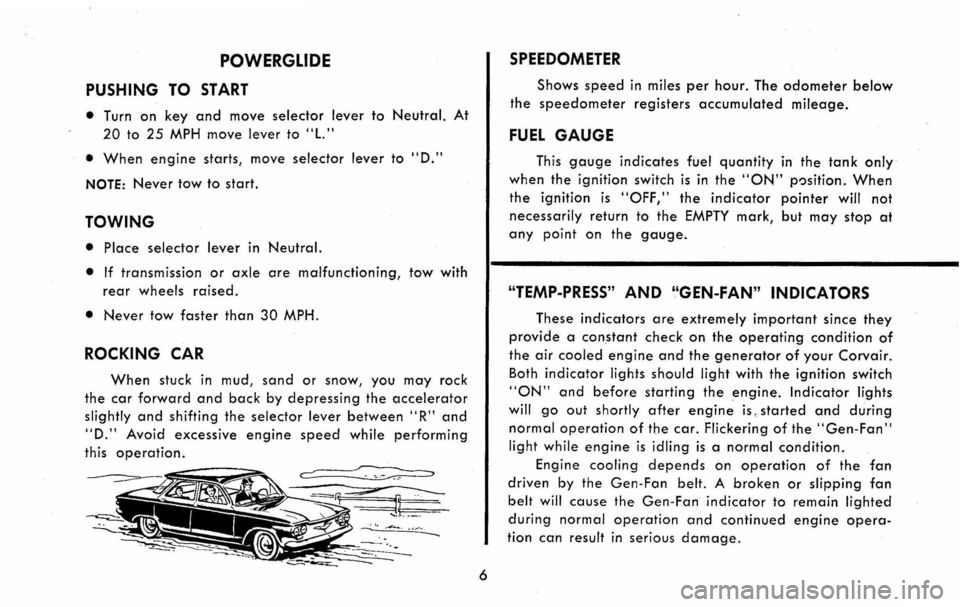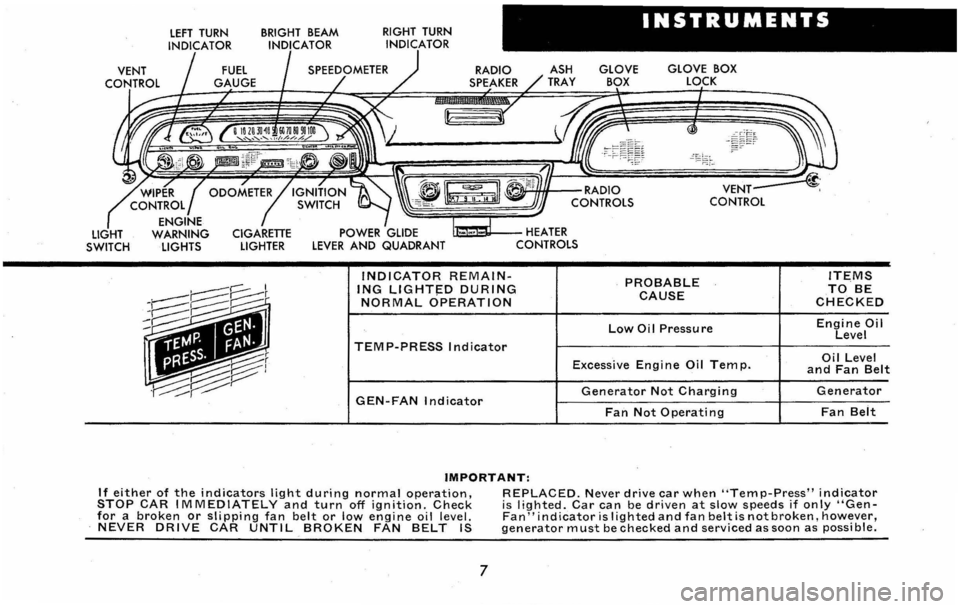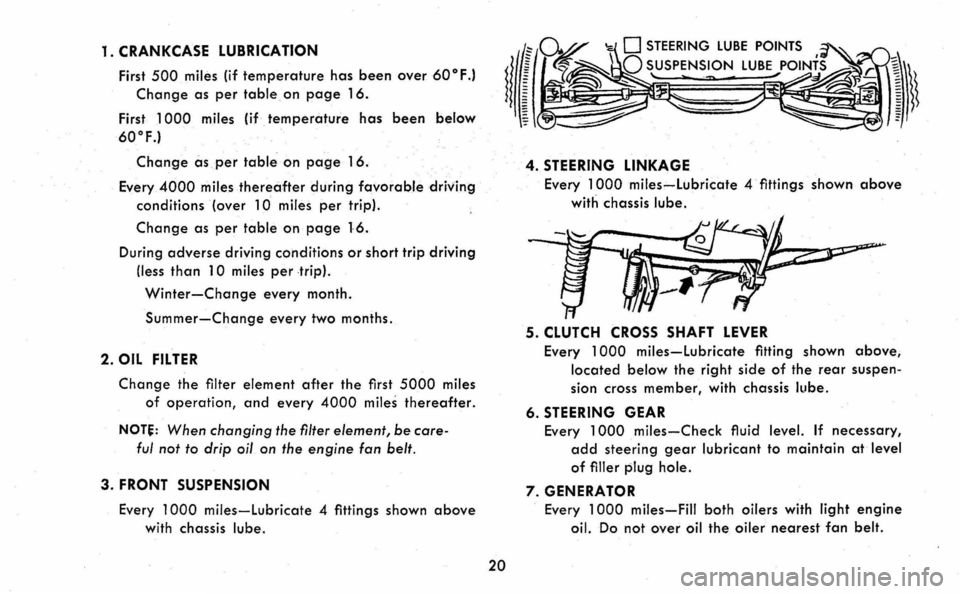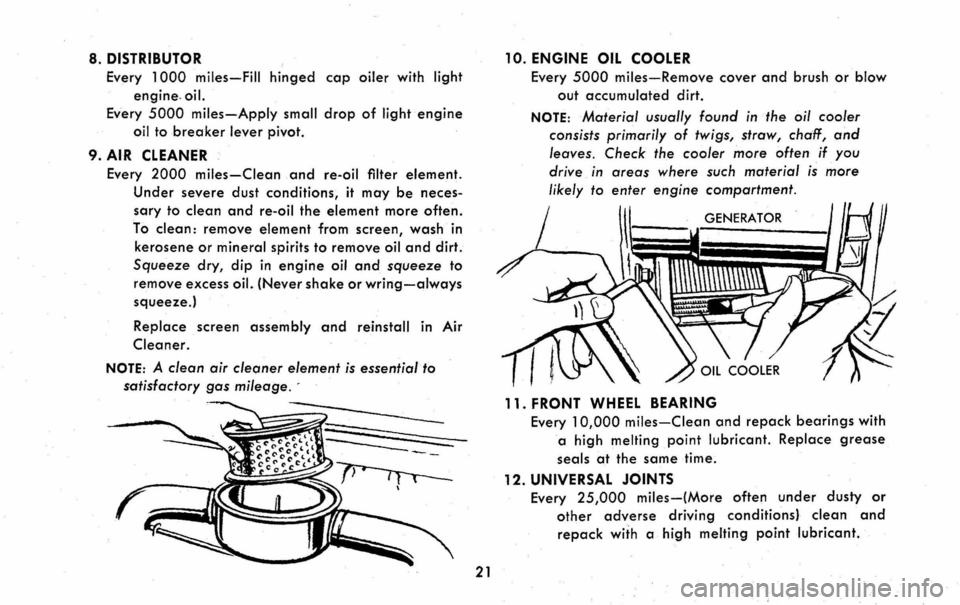check engine light CHEVROLET CORVAIR 1960 1.G Owners Manual
[x] Cancel search | Manufacturer: CHEVROLET, Model Year: 1960, Model line: CORVAIR, Model: CHEVROLET CORVAIR 1960 1.GPages: 38, PDF Size: 13.42 MB
Page 9 of 38

POWERGlIDE
PUSHING TO START
• Turn on key and move selector lever to Neutral. At
20 to 25 MPH move lever to "L."
• When engine starts, move selector lever to "D."
NOTE: Never tow to start.
TOWING
• Place selector lever in Neutral.
• If transmission or axle are malfunctioning, tow with
rear wheels raised.
• Never tow faster than 30 MPH.
ROCKING CAR
When stuck in mud, sand or snow, you may rock
the car forward and back by depressing the accelerator
slightly and shifting the selector lever between" R" and
"D." Avoid excessive engine speed while performing
this operation.
~ -'.
6
SPEEDOMETER
Shows speed in miles per hour. The odometer below
the speedometer registers accumulated mileage.
FUEL GAUGE
This gauge indicates fuel quantity in the tank only
when the ignition switch is in the "ON" p')sition. When
the ignition is "OFF," the indicator pointer will not
necessarily return to the EMPTY mark, but may stop at
any point on the gauge.
"TEMP-PRESS" AND "GEN-FAN" INDICATORS
These indicators are extremely important since they
provide a constant check on the operating condition of
the air cooled engine and the generator of your Corvair.
Both
indicator lights should light with the ignition switch
"ON" and before starting the engine. Indicator lights
will go out shortly after engine is, started and during
normal operation of the car. Flickering of the "Gen-Fan"
light while engine is idling is a normal condition.
Engine cooling depends on operation of the fan
driven by the Gen-Fan belt. A broken or slipping fan
belt will cause the Gen-Fan indicator to remain lighted
during normal operation and continued engine opera
tion can result in serious damage.
Page 10 of 38

LIGHT SWITCH
LEFT TURN
INDICATOR BRIGHT BEAM INDICATOR RIGHT
TURN
INDICATOR
INSTRUMENTS
RADIO SPEAKER GLOVE BOX
LOCK
~~"-fHIf--RADIO
~~~~~~~&J CONTROLS
U:a~II---HEATER CONTROLS
INDICATOR REMAINING LlGHT~D DURING NORMAL OPERATION
TEMP-PRESS Indicator
PROBABLE CAUSE
Low Oil Pressure
Excessive Engi ne Oil Tem p.
GEN-FAN Indicator Generator Not Charging
Fan Not Operating
IMPORTANT:
ITEMS TO BE CHECKED
Engine Oil Level
Oil Level and Fan Belt
Generator
Fan Belt
If either of the indicators light during normal operation, STOP CAR IMMEDIATELY and turn off ignition. Check for a broken or slipping fan belt or low engine oil level. NEVER DRIVE CAR UNTIL BROKEN FAN BELT IS
REPLACED. Never drive car when "Temp-Press" indicator i s lighted. Car can be driven at slow speeds if only "GenFan" indicator is I ighted and fan belt is not broken, however, generator must be checked and serviced as soon as possi ble.
7
Page 20 of 38

ure up to U. S. standards, it is desirable to' obtain
detailed information as to availability of fuels in a given
area and service and adjustments n~cessary to adapt
your car to the fuels available. Such information may be
obtained by writing:
General Motors Overseas Operations
Service Department, Room 9-164
General Motors Building
Detroit 2, Michigan
Include with your request the area to which you
plan to take your car and the vehicle type and serial
number.
COOLING SYSTEM CARE
The Corvair engine, being an air cooled engine, is
entirely dependent on the fan belt and blower to supply
sufficient volume of air for cooling purposes. The engine
fan belt should be checked for tightness at regular
intervals and replaced when necessary. Watch the
"Temp-Press" and "Gen-Fan" indicator lights on the
instrument panel for signs of engine overheating.
OIiIOJl~ll!I[olrolin! ...... ~'-~ ............ ,'.,./ .. / ... A/
Page 23 of 38

1. CRANKCASE LUBRICATION
First 500 miles (if temperature has been over 60° F.I
Change as per table, on page 16.
First 1000 miles (if-temperature has been below
60°F.1
Change as per table on page 16.
Every 4000 miles thereafte.r during favorab·le driving
conditions (over 10 miles per trip).
Change as per table on page 16.
During adverse driving conditions or short trip driving
(less
than 10 miles per trip).
Winter-Change every month.
Summer-Change every two months.
2. OIL FILTER
Change the filter element after the first 5000 miles
of operation, and every 4000 miles thereafter.
NOT~: When changing the filter element, be care
ful not to drip oil on the engine fan belt.
3. FRONT SUSPENSION
Every 1000 miles-lubricate 4 fittings shown above
with chassis lube.
20
4. STEERING LINKAGE
Every 1000 miles-lubricate 4 fittings shown above
with chassis lube.
5. CLUTCH CROSS SHAFT LEVER
Every 1000 miles-lubricate fitting shown above,
located below the right side of the rear suspen
sion cross member, with chassis lube.
6. STEERING GEAR
Every 1000 miles-Check fluid level. If necessary,
add steering gear lubricant to maintain at level
of filler plug hole.
7. GENERATOR
Every 1000 miles-Fill both oilers with light engine
oil. Do not over oil the oiler nearest fan belt.
Page 24 of 38

8. DISTRIBUTOR
Every 1000 miles-Fill hinged cap oiler with light
engine. oil.
Every 5000 miles-Apply small drop of light engine
oil to breaker lever pivot.
9. AIR CLEANER
Every 2000 miles-Clean .and re-oil filter element.
Under severe dust conditions, it may be neces
sary to clean and re-oil the element more often.
To clean: remove element from screen, wash in
kerosene
or mineral spirits to remove oil and dirt.
Squeeze dry, dip in engine oil and squeeze to
remove excess oiL (Never shake or wring-always
squeeze.)
Replace screen assembly and reinstall in Air
Cleaner.
NOTE: A clean air cleaner element is essential to
satisfactory gas mileage. -
21
10. ENGINE OIL COOLER
Every 5000 miles-Remove cover and brush or blow
out accumulated dirt.
NOTE: Material usually found in the oil cooler
consists primarily
of twigs, straw, chaff, and
leaves. Check the cooler more often if you
drive
in areas where such material is more
likely to enter engine compartment.
GENERATOR
11. FRONT WHEEL BEARING
Every 10,000 miles-Clean and repack bearings with
a high melting point lubricant. Replace grease
seals at the same time.
12. UNIVERSAL JOINTS
Every 25,000 miles-(More often under dusty or
other adverse driving conditions} clean and
repack with a high melting point lubricant.